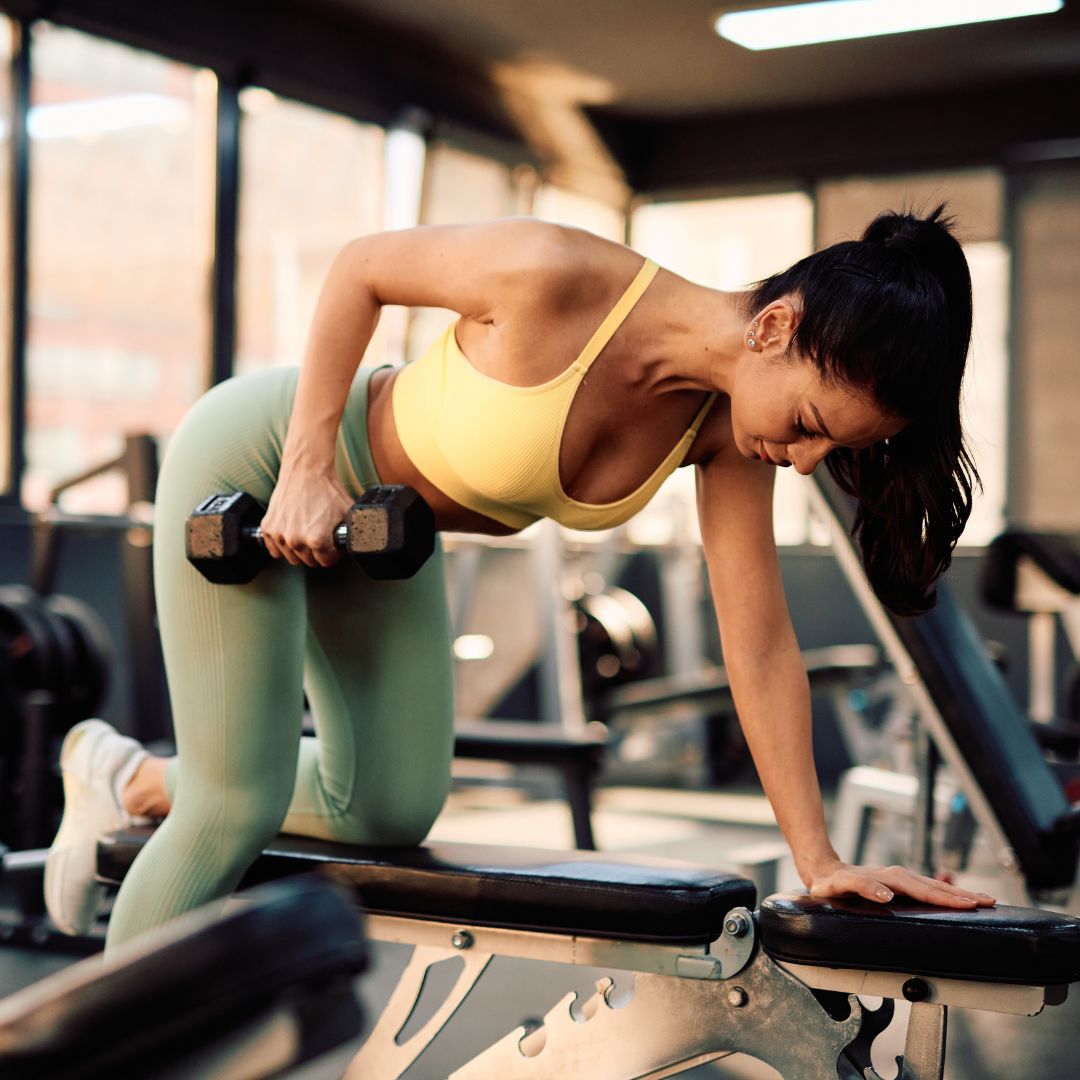
Looking to build a well-balanced, sustainable fitness regime? You'll need to incorporate some solid upper body work. It's all too easy to focus on leg day and cardio when we're looking for serious results, but overlooking your upper body strength is a sure-fire route to muscle imbalances, poor posture and even injury.
And you might be surprised to learn research (such as this study, published in the journal Biology (Basel)) shows that upper body training is associated with not only muscular gains, but also increased overall aerobic fitness too - so you're not compromising your cardio capacity by spending dedicated time on your chest, arms and shoulders.
One of our favourite upper body moves has to be the bent over row. A classic strength training exercise, it's a real powerhouse of a move, not only for building strength but also for improving posture and challenging core stability.
"Bent-over rows are a go-to exercise for most gym-goers as they target the back, shoulders, and arms while also engaging the core," notes personal trainer at OriGym, Abbie Watkins. "Because they target each of these muscle groups, they’re a really effective way to build upper-body strength and improve posture."
We also know that variety is the key to a successful training routine, and the bent over row has a plethora of equally effective variations you can weave into your regime. Whether that's switching up the style of weight you're using (kettlebells, barbells, and dumbbells will all train the muscles slightly differently) or combining the move with other similar (yet notably different) upper body exercises, you'll soon reap the rewards.
Need a quick refresher on exactly why we should all be strength training? You're in the right place. "Strength training is vital for overall wellbeing and health; it is consistently associated with improved mortality," explains personal trainer and founder of Building Body Confidence, Emma Simarro. "Benefits range from increased muscle mass and improved bone density, to a reduced risk of many diseases, including heart disease, diabetes, neurodegenerative diseases and many cancers. Not only this, but it's fantastic for boosting confidence, reducing the risk of injury, improving mental health, reducing stress levels and supporting hormonal health. If it was a pill, it would be prescribed to everyone!"
Say less: we're on board. Keep scrolling for the best bent over row variations that experts believe might just be superior for building upper body muscle, strength and tone. While you're here, do check out our guides to the different types of strength training, the best strength training workouts, a guide to strength training at home, and how our Senior Health Editor, Ally, got on when she tried out strength training for 30 minutes every week, too.
Mix up your strength training with these 7 bent over row variations
What is strength training?
First things first, though, let's take it right back to basics and look at exactly what strength training is.
"Strength training can also be known as resistance training, and it involves exercises designed to improve muscular strength, endurance, and hypertrophy by applying resistance to the muscles," explains trainer at Freeletics, Rowan Clift. "This can be done using free weights, machines, resistance bands, or even your own body weight.
"Strength training is often structured around compound movements, which engage multiple muscle groups simultaneously, and isolation movements, which target specific muscles," he continues. "A well-rounded strength training programme incorporates progressive overload, this means gradually increasing resistance over time to continually challenge the muscles."
@arielyu.fit ♬ original sound - Ariel Yu
What are the benefits of strength training?
We've touched on the wide-ranging, real-life benefits of incorporating strength training into your daily life above, but in case you missed it - don't sleep on the myriad of benefits that strength training yields.
"There are so many benefits to strength training," agrees Simarro, "so much so that health guidelines recommend that every adult should perform at least two full-body strength sessions a week. From daily improvements in our well-being, such as improved mood, sleep, stress levels, gut health, cognition, power, confidence and self-esteem, to physical health benefits, such as hormonal regulation, reduced risk of diseases such as diabetes, Alzheimer's and dementia, improved muscle mass, metabolism and bone health, it's no exaggeration to say that lifting weights and developing strength can and does save lives."
7 bent over row variations to try tonight
1. Push up
What? Upper body strength moves don't get much more classic than the push up (or press up, if you prefer.)
Why? "Push ups are a great upper body strength exercise, working several muscles at the same time, including chest, arms, shoulders and legs," notes personal trainer Emma Bord. "They can be performed at all levels by using variations, plus they can be performed with no equipment, anytime and anywhere. If you're looking to progress your push-up further, try adding pulses and holds."
How long for? Try a set of ten reps, and repeat for three sets.
2. Face pulls
What? Exactly what it says on the tin: an isolation exercise generally performed on a cable machine, you're essentially pulling a weighted cable towards your face, from a seated or standing position.
Why? "While not a heavy lift, face pulls are excellent for targeting the rear delts, traps, and rotator cuff muscles, which play a crucial role in shoulder health and posture," explains Clift.
How long for? As this is a lighter weight, make sure you're focusing on form - try three sets of ten reps.
3. Deadlift
What? Another super traditional strength move, the deadlift is the ultimate functional movement pattern, and one of the main power lifting moves too. It involves pulling a weight from the floor up to standing, holding the weight close to the legs as you hinge.
Why? "Deadlifts work nearly every muscle in the body, particularly the posterior chain, including the glutes, hamstrings, lower back, and traps," says Clift. "They also build raw strength, improve grip, and enhance core stability - a real powerhouse move."
How long for? Again, three sets of ten to 15 reps.
4. Pull-ups
What? A multi-joint exercise, a pull-up involves pulling the body up, using the upper body, while holding onto a horizontal bar.
Why? "Pull-ups and chin-up bodyweight exercises are unmatched for back and arm development," advises Clift. "They require significant upper body strength and engage the lats, traps, and biceps. Weighted variations allow for progressive overload to maximise results."
How long for? These are tough - aim for between two and five.
5. Lateral pull-downs
What? A compound upper body strength move, you'll pull the weighted bar down to chin height from a seated position.
Why? "If you can't manage pull-ups, lat pull-downs are a great alternative as they still engage multiple upper-body muscles like the lats, traps, and biceps," says Watkins.
How long for? Try three sets of ten reps.
6. Chest press
What? Another classic strength training move, the chest press can be performed using dumbbells at home or a barbell in the gym.
Why? "The bent over row is a fantastic 'pull' exercise, but the chest press, for example, is a great compound exercise to build our 'push' strength," says Simarro. "The same applies to squats, deadlifts, shoulder presses and so on. There are many different exercises we can include within our programmes to build strength in the different movement patterns - they all serve a slightly different purpose."
How long for? Aim for three sets of 15 to 20 reps.
7. Gorilla row
What? Not wanting to leave out the rowing motion entirely, the gorilla row is a variation on a bent-over row, where you'll hinge lower and alternate pulling each weight.
Why? "The gorilla row variation adds more dynamic control and power to a row," says Jenner. "Variations such as this prevent boredom, which should help keep you motivated and training more efficiently."
How long for? Try three sets of 15 to 20 reps.
Shop MC UK's go-to strength training essentials now:
Smash your progressive overload goals with this set of adjustable dumbbells. Choose different weights for different muscles, and ensure you're consistently challenging yourself with greater weights as you gain strength.
No room for weights? Pop these resistance bands in your basket, and you'll be able to up the ante on bodyweight moves in no time - but don't be fooled, they're more intense than they look!
We can't get enough of this vintage blue hue right now - plus, with Adanola, you can be sure that you're bagging both substance and style.
Is upper body strength training suitable for beginners?
In a word: yes. It's never too late to start strength training, but if you're a newbie, it's worth giving some thought to how you're going to structure your regime, both to reap maximum rewards and also avoid injury.
"If you're new to strength training, one of the most important things to remember is that you must ensure you're learning the correct form for each exercise," notes Clift. "Also, it's vital that you enjoy it; putting pressure on yourself to do something you don’t enjoy is counterproductive, so setting yourself realistic goals will help keep you motivated and on the right track.
"Don't be disheartened if it takes a while to get into it; it's not uncommon for people to struggle to create a relationship with exercise, especially if it’s new to them. Don’t be scared to try new things and push yourself out of your comfort zone, so that you find a style of training which works for you. Start slowly and try simple strength training exercises instead of going full steam ahead, as well as working out with friends and family to keep you motivated and accountable."







